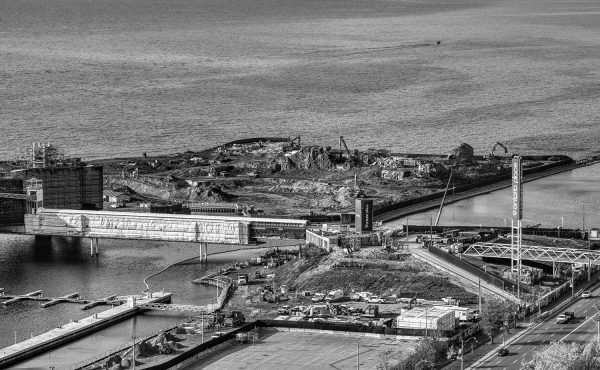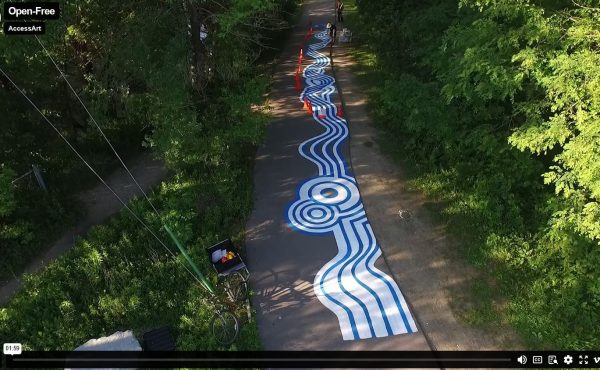 Continuing my series of thoughts about public space in other cities, I visited Vancouver for the first time in years earlier this winter. It’s a beautiful city, lovely to walk in, with a lot of attractive public spaces.
Continuing my series of thoughts about public space in other cities, I visited Vancouver for the first time in years earlier this winter. It’s a beautiful city, lovely to walk in, with a lot of attractive public spaces.
What struck me the most from a public-space point of view were the various initiatives for pedestrian street-crossings. For one thing, as you can see from the illustration at right, their “pedestrian crossing” signs are serious business — big, unmistakeable signs, much more noticeable than our little Toronto ones. They proclaim: this is a city that takes pedestrians seriously.
There were lots of crosswalks, and many were simply there, zebra stripes and a sign without lights. As I mentioned in my post about Rome, it was hard at first to work out what the local culture was around these crosswalks — when do you step out, and what can you expect from cars? For the most part in Vancouver, drivers were pretty respectful.
When the crosswalks did have signals, they were really impressive. Instead of a string of lights strung haphazardly over faint painted lines, as we have for the most part in Toronto, in Vancouver they are treated as real traffic signals, with lights and massive signs over the driving lane and zebra stripes on the pavement making them unmistakeable to drivers.

Perhaps the most remarkable feature, though, is the “flashing green” intersections they have on major streets. As we drove along Vancouver’s main streets, we were at first utterly baffled by the number of traffic lights that were constantly flashing green (it was pretty obvious they weren’t meant for left turns — Ontario drivers beware!). It was only when approaching from a side-street that I realized that at these intersections, when approaching from a side-street, cars only have a stop sign — no lights. There is only a pedestrian crossing signal. And the flashing green traffic signals can only be changed to red by pedestrians pushing a button. Imagine — traffic signals created solely for the convenience of crossing pedestrians! All over the city! (Needless to say, when cars had passengers, they would jump out and press the button to change the lights).
A final interesting aspect of Vancouver’s local residential streets was that, although they were not especially wide, and were two-way, they had parking on both sides. This left really only one lane for driving, and when cars encountered each other, they would have to slow almost to a stop and inch carefully by each other. It was great for creating a calm atmosphere — cars drove pretty slowly on residential streets at all times. The policy contrasts with Toronto, where all streets have to have wide open lanes, supposedly for fire trucks. Yet Vancouver’s fire services seem to manage just fine on these tightly-packed streets.




7 comments
What you left out about the pedestrian-controlled intersections is on the bike routes (which Vancouver has on streets that parallel the major streets) that there are also push-butons strategically located and oriented for cylcists to push them and change the lights with minimal effort. It’s a brilliant city, that one.
I’ve lived in VanCity my whole life…and while I agree with much of this, there’s a few things I’d like to clarify.
First off, I agree that there are more zebra crossings here, and that, generally, Vancouver drivers are more courteous to pedestrians than drivers in Toronto. Imagine me, with my Vancouver mentality, trying to jaywalk across Yonge near Eglinton. Let’s just say that people looked at me like I was completely mental.
Also, you could imagine my surprise when, driving in Toronto, I was informed about those flashing green lights. I was definitely one confused hippie.
The zebra crossings are nice to have, but one thing that I have to say is that they tend to give pedestrians an inconsistant sense of security. Sure, in some places, at some times, cars will stop. Indeed, this is the law here. However, oftentimes, drivers will forget this. I’ll admit, when I was a new driver, I’d be guilty as the worst of them.
Also, Toronto, being generally more congested in the urban core, is generally more like Rome in the sense that the roadway is governed moreso by give-and-take…at least in my opinion.
Also, I find that, while the City of Vancouver has been relatively proactive in this respect, other communities in the Lower Mainland are not as pedestrian-friendly. This may be due to a more prominent car culture in the lower-density cities, favouring vehicular movement over human-powered transportation, however, this is definitely an unscientific observation.
I’m sure that much does need to be improved in Toronto, but I just wanted to throw in my two cents.
Who knows? If I end up at Ryerson in a couple of months (like I’ve been praying), maybe I’ll change my mind. Until then, I’ll be dreaming of Kensington Market (sigh…).
That street looks as wide as King or Queen Street…
Clarification – my last paragraph refers to residential streets for housing (no pic provided), not main streets (what the crosswalk picture is).
As a temporary transplant to Vancouver, I too have spent some time mentally contrasting Vancouver’s pedestrian and cycling facilities to those of various Ontario cities. I totally agree with the quality of the pedestrian crossings and bike routes, and with the city’s commitment to improving them. Just recently in my neighbourhood alone, two sets of only zebra stripes have been changed to the flashing green light variety (one of which is only one block from another of the same kind).
The on-street parking on residential streets is an interesting story – apparently there was a significant public battle in the late 1980’s to allow it. A combination of city policy, NGO advocacy, and market forces finally shifted the tide because on-street parking is an important component of enabling secondary suites (i.e. basement appartments or up to complete duplexing of larger houses). Without the parking it is hard to legalize residential suites, but without the suites it is nearly impossible to densify the older residential neighbourhoods or to increase the availability of reasonably priced rental properties.
A couple of downsides to the on-street parking:
1) many residents (with or without rental suites) use it as an excuse to turn their back-lane garages into overflow storage capacity while consuming public road space to park their vehicles on a more-or-less permanent basis. If the parking strategy were soley a traffic calming benefit (and I recognize it is more than that) then we should officially narrow the road and widen the pedestrian space (the boulevards are nice but the sidwalks are frequently too narrow for two people with shopping bags or umbrellas to pass on the residential streets)
2) It is difficult for pedestrians, especially children, to check for on-coming traffic without stepping nearly halfway into the road to see around the parked cars. Most residential intersections are only 2 way stops and cars do tend to go above the speed limit (50km/h) when there is not another vehicle coming head-on. On the bike routes, and in some other places the city is installing traffic circles which are a better calming device at intersections, although they aren’t always so easily negotiable by pedestrians.
A few observations about Victoria, BC by a transplanted Torontonian…
The bright white zebra crossings and blinking green lights are also plentiful here. Some of our blinking green intersections are also magnetically sensitive to bikes in the intersection, which is amazing. I would say that drivers are not consistently courteous to pedestrians throughout the greater Victoria area – they’re quicker to stop for pedestrians in Oak Bay than Victoria, but slower in Saanich (all three of which are on my 20 minute bike ride to school). Though I did spend a few months adjusting to the local reality of having cars stop if I look like I _might_ want to jaywalk.
What I love as a pedestrian and hate as a driver here are the plentiful concrete traffic calming planters which prevents cars from travelling more than a few blocks in a residential street, they’re attractive and the one nearest my home has flowering shrubs now and blackberry bushes in August. They’re so much more attractive than Toronto’s scary concrete boxes that there is no comparison.
Vancouver also has a fantastic bike network:
This system is a pleasure to use and amazingly efficient. I could get from SFU to downtown in 40-45 minutes: the same amount of time that it took the Hastings express bus.